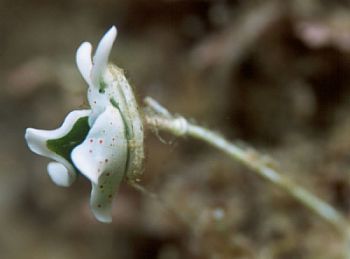

Elysia timida
(Risso, 1818)
Order: SACOGLOSSA
Superfamily: ELYSIOIDEA
Family: Elysiidae
DISTRIBUTION
Mediterranean, Canary Ids. Possibly Caribbean.
PHOTO
Upper: Elysia timida feeding on an Acetabularia. Baie de Peyrefitte (French / Spanish Mediterranean border), depth 2m, 23 September 2000. Photo: Patrick Heurtaux.
Lower: Fethiye, Turkey, Depth: 1 - 2 meters, December 2002. Photo: Orhan Aytur
Elysia timida is considered to be a Mediterranean endemic which feeds on the green alga Acetabularia acetabulum in Spring and Summer, but in the early Autumn (September) they begin to associate with Padina pavonia. It retains functional symbiotic chloroplasts from its food within the cells of its digestive system. Usually has large red or orange spots on parapodia, head and rhinophores.
See Erwin Koehler's Mediterranean Slug Site for a collection of photos showing colour variability in this species.
See Elysia cf. timida Page for records of this species, or something similar, from the Caribbean.
References:
• Risso, A. (1818). Memoire sur quelques Gasteropodes nouveaux, Nudibranches et Tectibranches observes dans la mer de Nice (1). Journal de Physique, de Chimie, d'Histoire naturelle et des Arts, Paris 87: 368-377.
• Marin, A., Ros, J.D (1992) Dynamics of a peculiar plant-herbivore relationship: the photosynthetic ascoglossan Elysia timida and the chlorophycean Acetabularia acetabulum. Marine Biology. 112: 677-682, Figs 1-10.
• Jensen, K.R. (1992). Anatomy of some Indo-Pacific Elysiidae (Opisthobranchia: Sacoglossa [=Ascoglossa]), with a discussion of the generic division and phylogeny. Mal. Soc. London, 58: 257-96.
Rudman, W.B., 2001 (April 9) Elysia timida (Risso, 1818) . [In] Sea Slug Forum. Australian Museum, Sydney. Available from http://www.seaslugforum.net/find/elystimi
Related messages
Elysia timida from the French Mediterranean [3]
November 1, 2007
From: Dominique Horst
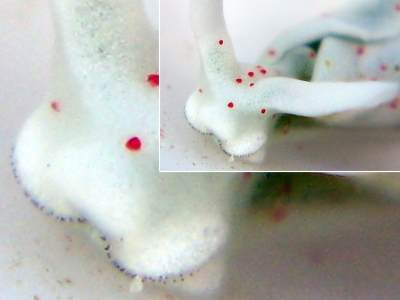
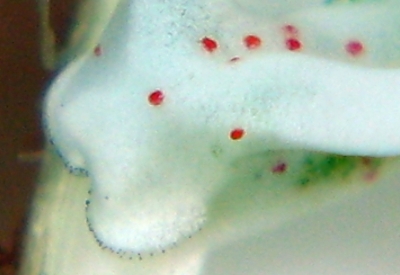
Hello Bill,
Here are more shots about another specimen of Elysia timida, which show details about their kind of teeth.
Locality: Antibes Cape, 7 m, France, Mediterranean sea, 27 October 2007. Length: 4 mm. Photographer: Dominique Horst.
Many thanks and kind regards,
Dom.
dominique.horst@wanadoo.fr
Horst, D., 2007 (Nov 1) Elysia timida from the French Mediterranean [3]. [Message in] Sea Slug Forum. Australian Museum, Sydney. Available from http://www.seaslugforum.net/find/21025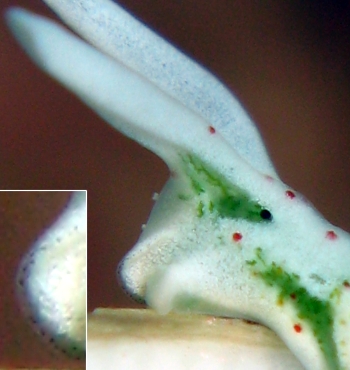
Dear Dom,
I guess when you say teeth you are talking about the black spots along the edge of the upper lip. They certainly look like little black spikes but in your side-on view in the photo alongside you can see that the edge of the lips are not white, but have a translucent-transparent edge, and the black specks are embedded in that.
Sacoglossans, like Elysia, are characterised by a special form of the mollusc radula in which there is a single row of teeth, each tooth usually being the shape of a knife blade or dagger, which they use for piercing a hole in the cell wall of their plant food so they can suck out the cell contents. The radula teeth of molluscs is on a tongue-like ribbon rather than part of a pair of biting jaws like us.
Which brings us back to the black things. I have no idea what they are. Having a look at one of Arnaldo Marin's papers (1993) in which he describes the development of the larvae, he says that newly hatched juveniles 'progressively develop black epidermal pigment which covers the head .. tip of rhinophore rudiments and the oral lobes...' I can't see any mention about when they lose this black pigment, but I suspect your mystery black specks are the remains of this black pigment. Hopefully someone can help us
-
Marin, A. and Ros, J. (1993) Ultrastructural and ecological aspects of the development of chloroplast retention in the sacoglossan gastropod Elysia timida. Journal of Molluscan Studies 59: 95-104.
-
Marin, A. and Ros, J. D. ( 1989) The chloroplast-animal association in four Iberian Sacoglossan Opisthobranchs: Elysia timida, Elysia translucens, Thuridilla hopei and Bosellia mimetica. Scientia Marina 53: 429-440.
Marin, A. and Ros, J. D. ( 1992) Dynamics of a peculiar plant-herbivore relationship: the phtosynthetic ascoglossan Elysia timida and the chlorophycean Acetabularia acetabulum. Marine Biology 112: 677-682, Figs 1-10.
Best wishes,
Bill Rudman
Elysia timida from the French Mediterranean [2]
November 1, 2007
From: Dominique Horst
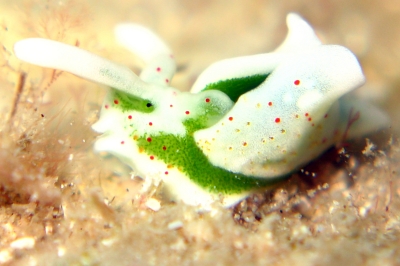
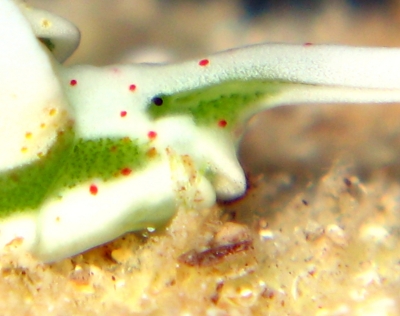
Hi Bill,
I found this Elysia at the same place where I left it yesterday ... [see message #20998 ]
Locality: Antibes Cape, 7 m, France, Mediterranean sea, 21 October 2007. Length: 8 mm. Photographer: Dominique Horst.
With more time, shots are better. Details on the digestive system are visible.
Many thanks and kind regards,
Dominique
dominique.horst@wanadoo.fr
Horst, D., 2007 (Nov 1) Elysia timida from the French Mediterranean [2]. [Message in] Sea Slug Forum. Australian Museum, Sydney. Available from http://www.seaslugforum.net/find/21006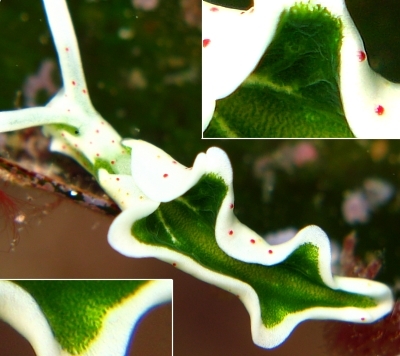
Thanks Dom,
Obviously it was not so 'timid' this time. These nice photos show details of the head and the branching of the digestive gland very clearly. The two whitish lines are the main branches of the pattern of branching blood vessels which can be seen on the inside of the parapodia.
Best wishes,
Bill Rudman
Elysia timida from Antibes, Mediterranean Sea
October 31, 2007
From: Dominique Horst
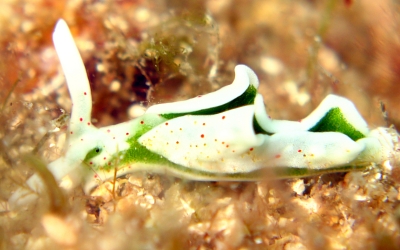
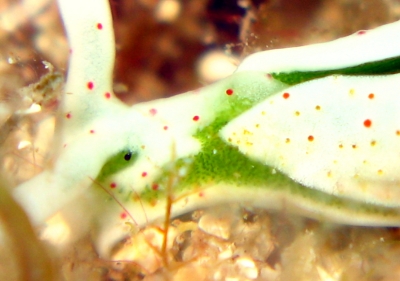
Hi Bill,
Not very frequent in our area, I think this is Elysia timida.
Not sure what timida means, but this one was crawling so fast, that it was hard to have a correct shot.
Locality: Antibes, 6m, France, Mediterranean sea, 20 October 2007. Length: 6 mm. Photographer: Dominique Horst.
Many thanks and kind regards,
Dom.
dominique.horst@wanadoo.fr
Horst, D., 2007 (Oct 31) Elysia timida from Antibes, Mediterranean Sea. [Message in] Sea Slug Forum. Australian Museum, Sydney. Available from http://www.seaslugforum.net/find/20998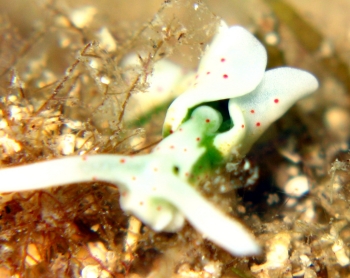
Dear Dom,
The word timida means timid or fearful but I am not sure why it was used for this species. I sympathise with the apparent speed your animal was crawling. Small animals at high magnification seem to move much faster than larger ones, but its just that the background is magnified as well so they don't have to move very far to get out of your photo frame, or focus.
Elysia timida is a solar-powered species, and in the close-up I have included you can see the darker green specks which are chloroplasts from the algae it feeds on.
Best wishes,
Bill Rudman
Elysia timida from Fethiye Bay, Turkey.
July 14, 2004
From: Ant Turkmen
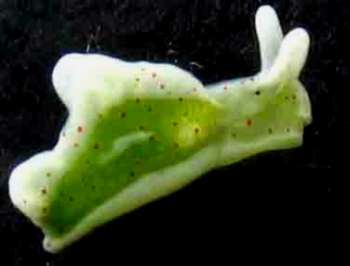
I am carrying out a research on the Opisthobranchs of the Fethiye Bay, Turkey for my PhD thesis. The photographed specimen of Elysia timida was collected during my dives of the last weekend [March 2004]. It was at 1m depth, on rocks covered with algae.
Ant Turkmen
Marine Ecologist.
Hacettepe University, Turkey.
antturkmen@superonline.com
Turkmen, A., 2004 (Jul 14) Elysia timida from Fethiye Bay, Turkey.. [Message in] Sea Slug Forum. Australian Museum, Sydney. Available from http://www.seaslugforum.net/find/12596Dear Ant,
Good Luck with your research. I look forward to hearing from you about your studies and interesting observations
Best wishes
Bill Rudman
Re: Solar Powered Species - Elysia timida
February 21, 2004
From: Levent Cavas
Dear Ant,
Concerning your message [#12075]:
I have been observing the invasion of Caulerpa racemosa in Seferihisar (İzmir-TURKEY) since last May. I observed Elysia timida about 1-2 meters deep, however, they are not as abundant as your ovservation, about 1-2 per square meter.
Kind regards,
Levent Cavas MSc.
University of Dokuz Eylul, TURKEY
lcavas@deu.edu.tr
Cavas, L., 2004 (Feb 21) Re: Solar Powered Species - Elysia timida. [Message in] Sea Slug Forum. Australian Museum, Sydney. Available from http://www.seaslugforum.net/find/12279Solar Powered Species - Elysia timida
February 20, 2004
From: Ant Turkmen
I am a PhD student in Turkey. I am very interested in Solar Powered Species and would like to know if the zooxanthellae symbiosis does exist in Elysia timida.
Two years ago, in Yumurtalık (Iskenderun Gulf of Turkey), I've observed very large numbers of E. timida on the algae covered rocks of the littoral zone (0-1m). It was late August. Abundance was 8-10 per square meter. Is this abundance normal for this species? Has anyone recorded similar numbers within the related taxa?
Ant Turkmen
antturkmen@superonline.com
Turkmen, A., 2004 (Feb 20) Solar Powered Species - Elysia timida. [Message in] Sea Slug Forum. Australian Museum, Sydney. Available from http://www.seaslugforum.net/find/12075Dear Ant,
Species of Elysia can be 'solar powered' but they don't keep functional zooxanthellae in their bodies as many nudibranchs do. They are sacoglossqans, which are hebivorous, and instead keep chloroplasts from their algal food alive and functioning. E. timida is indeed a species which does this. Here is a good reference on the topic:
• Marin, A., Ros, J.D (1992) Dynamics of a peculiar plant-herbivore relationship: the photosynthetic ascoglossan Elysia timida and the chlorophycean Acetabularia acetabulum. Marine Biology. 112: 677-682, Figs 1-10.
Also have a look at the other messages on this page
Best wishes
Bill Rudman
Elysia timida from Turkey
September 12, 2003
From: Ferda Büyükbaykal
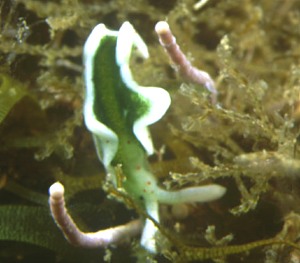
Dear Bill,
Here is a slug from Uc Adalar, East coast of Turkey.
It was seen on 18 May 2003, Dive site: Uc Adalar (South-west of Turkey, Mediterranean coast,] Size: 2-5 cm, Depth: 13-25m.
Thanks for any help in identifying it.
Ferda Büyükbaykal
ferdabbaykal@isnet.net.tr
Büyükbaykal, F., 2003 (Sep 12) Elysia timida from Turkey. [Message in] Sea Slug Forum. Australian Museum, Sydney. Available from http://www.seaslugforum.net/find/10116Dear Ferda,
This is Elysia timida.
Best wishes,
Bill Rudman
Elysia timida from Turkey
April 24, 2003
From: Orhan Aytur

Dear Bill,
I understand solar powered sea slugs are one of your specialities. Here are three photographs of an Elysia timida.
Location: Fethiye, Turkey
Depth: 1 - 2 meters
Date: December 2002
Cheers,
Orhan
aytur@ee.bilkent.edu.tr
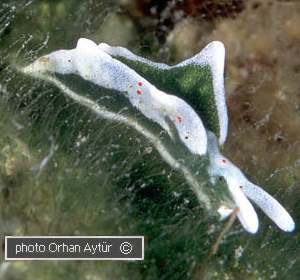
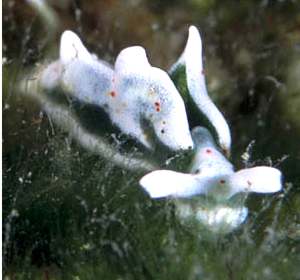
Thanks Orhan,
Elysia timida is certainly a very colourful example of this group of fascinating animals
Bill Rudman
Elysia timida from French Mediterranean
August 2, 2002
From: Marina Poddubetskaia
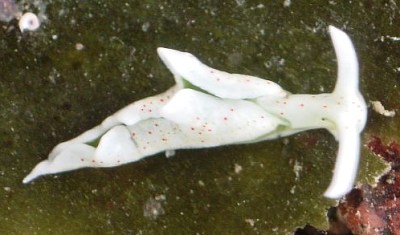
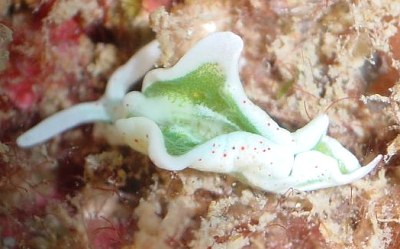
Dear Bill,
There are some photos of Elysia timida
Date: July 02, 2002
Location: Cerbere, France (Mediterranean coast)
Site: L'Ocell
Size: 15-20mm
Photos: Marina Poddubetskaia - Nembro website
Best wishes,
Marina.
nembro@nembro.info
Poddubetskaia, M., 2002 (Aug 2) Elysia timida from French Mediterranean. [Message in] Sea Slug Forum. Australian Museum, Sydney. Available from http://www.seaslugforum.net/find/7550Thanks Marina,
The bright green plant chloroplasts, in the digestive gland, are clearly visible in this species.
Bill Rudman
Elysia timida feeding
April 23, 2001
From: Patrick Heurtaux

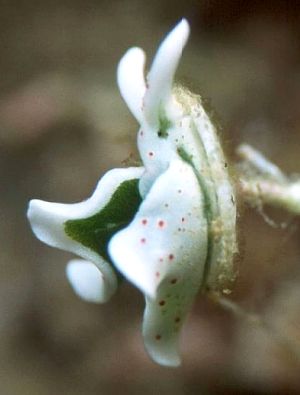
Dear Dr Rudmann
Here is a photo of Elysia timida feeding on an Acetabularia.
It was at the Baie de Peyrefitte (French / Spanish Mediterranean border), depth 2m, on 23 September 2000
Best wishes
Patrick
pheurtau@club-internet.fr
Heurtaux , P., 2001 (Apr 23) Elysia timida feeding. [Message in] Sea Slug Forum. Australian Museum, Sydney. Available from http://www.seaslugforum.net/find/4217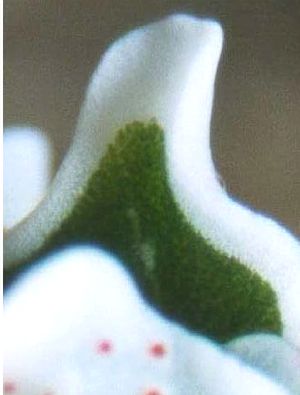
Dear Patrick,
Thanks for the wonderful photo. Acetabularia is a fascinating alga, and Elysia timida is indeed a fascinating sea slug. I have included an enlarged copy of your photo to show the inside of one of the parapodia. The mottled green region is where the green chloroplasts from Acetabularia are stored and kept alive in specialised branches of the digestive gland. Elysia timida, like other Solar-powered sacoglossans, is able to keep the chloroplasts it ingests from its algal food alive and functioning in its own body. Your photo shows the aggregations of chloroplasts very well.
Best wishes,
Bill Rudman
Elysia timida mating
April 11, 2001
From: Erwin Koehler
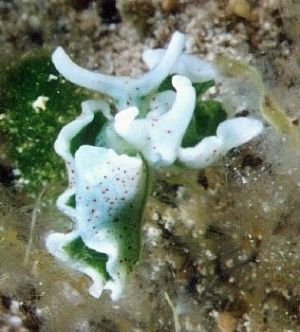
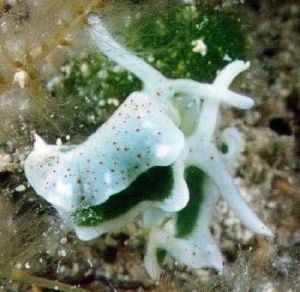
Dear Bill,
Attached are 2 photos from my recent trip to Malta. I took them at Qawra Point, at 8 m depth, size ~2cm, March 17, 2001.
Erwin
Erwin@medslugs.de
Koehler, E., 2001 (Apr 11) Elysia timida mating. [Message in] Sea Slug Forum. Australian Museum, Sydney. Available from http://www.seaslugforum.net/find/4154Thanks Erwin,
Bill Rudman
Photos of Elysia timida
April 9, 2001
From: Bill Rudman
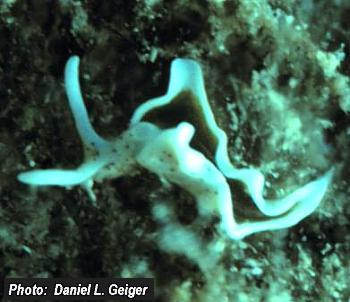
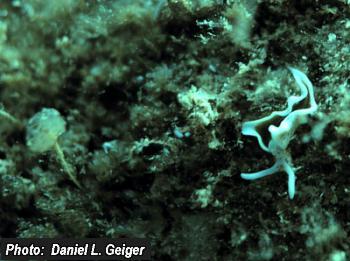
Here are 2 photos of Elysia timida from Daniel Geiger.
Data:
Ille de Bendor, Bandol, France, 1989. Note one plant of its algal food, Acetabularium, in left of lower photo. Photo: Daniel L. Geiger
Bill Rudman
Rudman, W.B., 2001 (Apr 9) Photos of Elysia timida. [Message in] Sea Slug Forum. Australian Museum, Sydney. Available from http://www.seaslugforum.net/find/9768